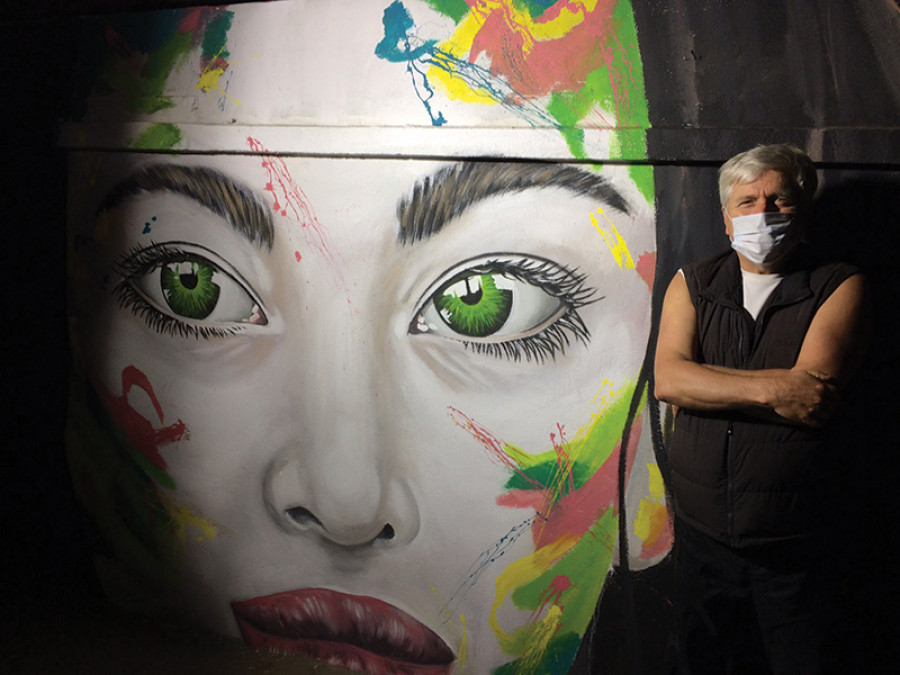Entertainment
Wall of Hope
As you pass Hotel Himalaya in Lalitpur, your eyes are bound to linger on the wall separating it from the busy traffic on the road. Women’s faces, reclining bodies, flora and fauna in tints of red and shades of white,
Kurchi Dasgupta
As you pass Hotel Himalaya in Lalitpur, your eyes are bound to linger on the wall separating it from the busy traffic on the road. Women’s faces, reclining bodies, flora and fauna in tints of red and shades of white, greens, blues and yellows alongside charcoal black have taken over the space, with occasional words giving direction to its flow. A pair of plaques near the entrance to the hotel informs you that the piece is called ‘Neglected’ and is painted in support of the ‘Badi Andolan’ of 2007. What it leaves out is the fact that the mural is part of a much bigger picture—the ‘Wall of Hope Campaign’, which began five years ago, and has over time impacted over 20,000 youth in Nepal in an effort to stop violence against women and girls. The ‘Wall of Hope’ series of wall murals started as a change-making initiative by Human Rights Film Focus Nepal (HRFFN) in 2013 and till now 350 such walls have been created across Nepal with Rachiv Dangol as the art co-ordinator. It ‘provides a platform for education, artistic expression, and advocacy,’ and is ‘designed for students, ages 13-24 years old. The Campaign is a call for action, and a challenge for young people to commit themselves to learning more, and doing more to stop violence against girls and women.’ It now has a global reach in terms of gender violence issues, and still retains two basic and unifying elements—that of educating young people on human and gender rights through film screenings followed by interactions, and the creation of a ‘wall of hope’ nearby.

‘Neglected’ is a mural driven by the artistic acumen of Benjamin Swatez, who has the distinction of having created murals in 17 countries across the world apart from holding art therapy workshops. His work is consistently focused on the plight of refugees, the socio-economically marginalised and the vulnerable—he has led projects on Syrian refugees in Jordan, and also projects in Greece, Congo and Sudan. Therefore, his week-long visit to Nepal in support of ending violence against women comes as no surprise. Dolores Maritina of Mexico, and her daughter Andrea Meral, have joined the team. When I picked up a brush to put on the finishing touches on a red skirt one afternoon, I was surprised to find the veteran Lok Chitrakar on my right, and an art school student on my left—both equally immersed in bringing the mural to life. Quite an amazing range no doubt and this speaks to the goodwill that the ‘Wall of Hope Campaign’ enjoys in Nepal. Nearby stood Bev Hoffman, carrying a bag full of ice cubes that he readily applied to the painters’ foreheads whenever they felt dizzy from the scorching sun. Only later did I learn that the unassuming man was the Ex-Director of HRFFN and now was its international advisor.

Words like ‘dignity’ and ‘forgiveness’ were scrolled between water splashes and flying peacocks, between wide eyes and luscious lips, passersby stopped in their tracks and came up to ask whether it all meant what they thought it did. People scrambled out of vehicles to catch a closer glimpse of the images, while mobile phones came out of pockets and bags to grab some selfies next to it. The ‘Badi Andolan’ and the iconic image of Uma Devi Badi protesting astride the Singha Durbar gates has certainly given visual impetus to the project, and triggered its symbolic layers, but the mural seems to have expanded beyond socio-economic boundaries in affecting people, especially women.
I could not help but notice the regularity with which women and girls came up and asked about the piece, which is probably Nepal’s longest mural given that it spans the length of a football field. The murals by themselves will not revert the numbers of girls who are trafficked, or change the material and social conditions of the poor and marginalised but it sure seems to be doing what it was originally meant to, that is raise awareness and initiate conversations which might ultimately affect said problems. I like to think there is hope in art.




 5.39°C Kathmandu
5.39°C Kathmandu










